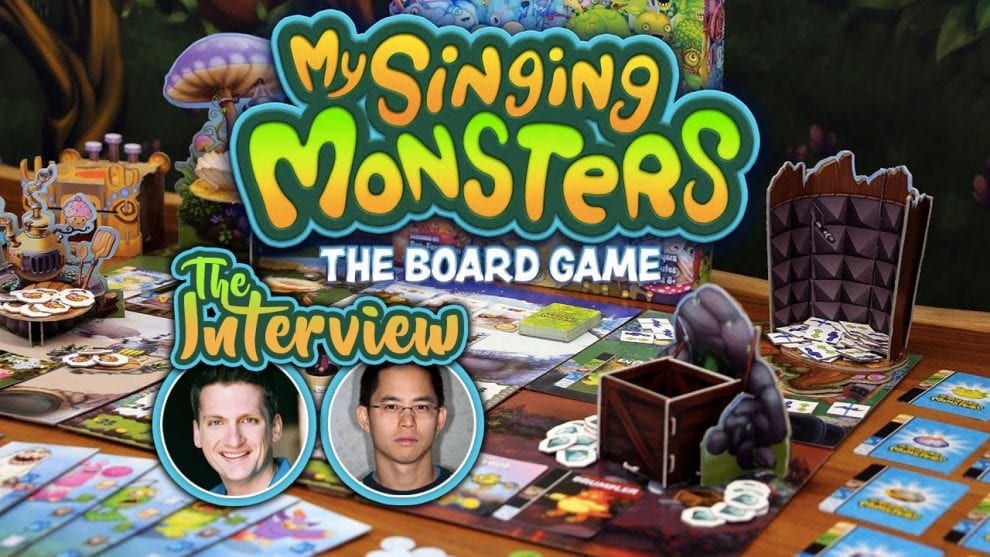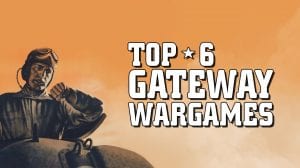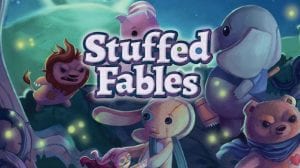
and Publisher of Off the Page Games. Pictured right is designer and Professor Sen-Foong Lim.
I had a good time talking to the designers of the My Singing Monsters game Jay Cormier and Sen-Foong Lim. Our interview was quite a long one, but I hope that prospective buyers of the My Singing Monsters game and anyone interested in game development will learn everything they need to know from this!
To start off, could you introduce yourselves and Big Blue Bubble to the Meeple Mountain audience?
Jay: I’m Jay Cormier, a game designer and also a publisher… Sen and I have designed a bunch of games together, on our own and with other people. Together we designed a game called Mind MGMT, which I became a publisher for and it is hitting backers within the next month or two.
Sen: And I am Sen-Foong Lim. I’m a freelance boardgame designer and developer and an RPG author and I’m a Professor at Fanshawe College in London, Ontario Canada.
How long have you been designing games?
Sen: My oldest child’s age minus two years, so it’s 15 years we’ve been designing games seriously and probably 5 years before that is when we started.
What makes My Singing Monsters unique?
Jay: I think that one of the biggest things that makes this unique is the fact that the game can grow with your family. And the fact that you can play level 1, which is one island and has kind of easy rules to play, not Uno easy, but easy enough that you know what you can do on your turn. And it could be the game that you play forever. Eventually, you might want to add island two and you could play that forever. Or island three or four or five. By the time that you get to island five we think that is a nice strategy euro family game that strategy gamers would like.
Sen: The mechanisms that are not necessarily unique, but are fairly well used in this game, my favourite part is the jockeying for scoring position. And the flexibility in when you can score and turn in your stuff for points. So you can exploit your positioning really well and jump over people because they are in the way. It makes me giddy every time we play. The more players that are playing makes this happen more often as well. And the neatest thing I think in this game is the end. The end is super tight usually, and there are surprise moments and tension at the end. You have to end it strong because I’m never going to get another turn and you watch everyone else catch up.
Jay: I’ll add one more thought to why the game is unique, we are married to the brand of My Singing Monsters well in that so many of the actions in this game are feel good actions. Even when your neighbour does something good you’re like “hey I’ve got a decoration so I get something too” or when people score points you can jump over them and say “thanks a lot.” It feels like it’s perfect for the brand, because it is collaborative, just like the creation of music. This game has a lot of fun, happy feelings throughout. You know, some games are cutthroat, it is competitive but friendly in a weird way.
We started talking about competition and how My Singing Monsters has the ability to get new people involved in the hobby. This conversation brought up some interesting insights into how the game was designed.
How did the development of My Singing Monsters evolve?
Jay: The whole game started off as a worker placement game. But because it was an IP we wanted to show off the art so maybe it would be the cards as workers. And then it morphed into how it is now. I’m going to place the worker here in this thing to activate that thing. But that is a very easy and fun way to introduce people to worker placement games. When we first showed it to Big Blue Bubble, we had all five islands. We thought this was the game. We tested it and they gave us some gamers and they were playtesting it and thought it was great, but then we got past that group of people and got to normal people and they playtested it and were like, “I don’t know what’s going on!” They had only played Uno and the like. They said, “If you could reduce it to one island that would be great.” But I was thinking we couldn’t have only one island in a worker placement game. Originally, we only had breeding on one space, but we eventually talked about It and thought, what if every spot could breed? Then it became more interesting and morphed into a game that works with only one island.
Sen: The first batch of playtesters were the programmers and designers and those types of people. The second batch were…not those people. Not people who were invested in making the My Singing Monsters app. The initial testing was super helpful, we would not have gotten as far in the short amount of time we had. It was quintessential to getting the game done as quickly as it was with the quality that it has. There were days when we tested it three times a day with different people.
How was working on My Singing Monsters different from working on mobile games? (How was it working with the mobile game team?)
Sen: What happened was that they (Big Blue Bubble) had decided that they wanted to diversify the product and make a boardgame. My friends work there and said, “We know someone local who has made a lot of games.” So, they reached out to me and I brought Jay on the project. That’s how it happened. They were looking for someone to help them make this game and show them the ropes of the boardgame industry.
Jay: Sen and I had worked together on a lot of IP games. Sen himself has worked on translating an app, Kingdom Rush.
Sen: The idea that is really common in boardgaming is that no one really wants a one-to-one translation. Apps can do the calculations and deal the cards for you. People don’t want an emulation or an approximation, but want something that has the feel of the game. You interact with the characters and the pieces in a way you wouldn’t in the app.
Jay: Case in point for My Singing Monsters, when people heard about it they questioned, “The game is all about making music, how are you doing that in a boardgame?” You’re placing notes on a staff, so you’re making music. There’s no actual music that’s played, even though we tried to do that throughout playtesting. But breeding is a big part of the game, put two one element monsters together and you get a two element monster, and then you can breed that one and get a rare, and there are treats. Everything that is in the app is in the boardgame, a lot of the biggest things that makes the app wonderful are there.
Sen: So all the things that say, “These are the touchstones of My Singing Monsters,” we wanted to include in the game. As Jay says there’s a huge realm of stuff. We went with the first thing ever released because even if you’ve only played it once you’ll know the Mammot. It’s only the people who get real deep will know all the creatures from the other islands. We went with the lowest common denominator. The commonality. It shows the strengths of the system. There may be room for expansions or different games if the IP does well.
Jay: The element tokens used to have a one syllable on the reverse side. Like a bah, or a hum, and the idea was that when you finished your song you would play it and approximate the notes.
Sen: BE, BAH, BUM!
Jay: Yeah, as a strategy game we thought no one would actually do it. It’s subjective, did you do it good enough? It’s more a party game then.
What was your favourite aspect of the game to design?
Jay: We kept this initial idea of keeping the worker placement as cards. That was my favourite idea. Getting a rare one, for example, was fun.
Sen: I think my favourite part of the design was trying to fit all the elements from the world into the game and obviously there is much more, but the stuff we did fit in I believe we did a good job.
How did you try to stay loyal to the mobile game? Was it difficult?
Sen: No, we only had trouble defining what the treats did. They didn’t function like they did in the app.
Jay: For a while we had happiness in there, where you level up your monsters and that was part of the app. The angle originally was making yourself a house and turn it into a bigger and bigger castle. When we brought it down to the one board game, there’s no way to do that, and that’s where we came up with the jumping and scoring bits. The jumping was actually super fun. We had to…actually kill happiness. For the longest time when you put down a monster you could take up the one underneath it. But that was a lot of steps. It caused a lot of ramp up and was too quick.
Sen: It was a neat idea, but in execution it fell on its face. It’s funny, when we had decided on the castle size, and the bigger castle the better, and that’s your win condition. Jay and I have this thing where we don’t like points. It’s too generic. Getting a bigger castle was what you needed to win the game. It makes sense, but man was that scoring fun. For the sake of the fun we led it down a lot of other roads that incorporated music stuff, like shifting notes around. It really accentuates a lot of the other parts of the game like the recording studio. If we kept the other way it would be a lot of micromanaging, small decisions, that may not have ended up being as fun for as many people.
What are your favourite board games? What games inspired the mechanics for the My Singing Monsters game?
Jay: We want to make sure there is something unique with each of our games. Why bother just copying things. I like Dominion a lot, I have a big custom box of Carcassonne, I’m not necessarily a ‘cult of the new’ guy but I like when new games do something clever. I got Canvas recently and I like how the transparent cards help make a painting. I like games that do things that I haven’t seen before.
Sen: My favourite game is I’m the Boss and it’s not at all like My Singing Monsters. You’re all yelling at each other and trying to negotiate. There’s not a lot from any of my favourites in this game at all. Looking left and right is kind of common in games, even the breeding isn’t really from anything else because it is specifically from My Singing Monsters. There aren’t a lot of games like that, especially in Worker Placement games where you’re constantly improving your workers. I don’t think there’s a lot in common with my favourite games. But I think that’s the neat thing about well designed games, they can be an amalgam of different things that you like. They can also be all the stuff you don’t like but come together. That is what My Singing Monsters became. It’s a family game but in the end, I like this game much more than a lot of hardcore games, mostly because of the story.
What was the development process like for the game, how long did it take?
Jay: I don’t know if they want to advertise that!
Sen: We played a lot.
Jay: The process was sped up. The playtesting would normally have taken much longer but it was compressed. It took six months.
Sen: We had a compressed timeline because of how much it was playtested. We playtested it as much as we would have playtested a normal game, usually six months, but with My Singing Monsters we did far more playtesting in the same amount of time. It was heavily, heavily, heavily, playtested.
You’re putting this game on Kickstarter, why Kickstarter?
Jay: For the exact reason that Kickstarter exists. The demographic of the My Singing Monster app is quite young, so Big Blue Bubble is not sure how well a boardgame would do. That’s the whole point of Kickstarter. Gauge interest.
Sen: This is a userbase that is not used to paying for something unless they really, really, want it. But this is a demographic that is underserved. Big Blue Bubble is the only producer of My Singing Monster stuff. There are some books, plush toys, but that’s it. It’s a market that has moved to other stuff, but do they have room for a $50-$60 game? That’s why Kickstarter is a good step.
Any nerves or challenges regarding the success of the Kickstarter?
Jay: The only challenge is that the cost of manufacturing is going through the roof. I’m experiencing this now with Mind MGMT. It’s currently being shipped right now but there are ships lined up at ports. Everything is costing more.
Sen: There was a time a couple months ago where you couldn’t even find a container. We are also experiencing an increase in base costs, like for paper. Even now manufacturers are telling us that quotes we get are only being honoured for a couple weeks at a time. It’s caused a lot of trouble.
Because Big Blue Bubble has developed teaching guides for the My Singing Monsters app do you think there will be any teaching supplements available to get the board game into the classroom?
Sen: I would love that. It’s an interesting thing. The thing that educators care about is that things don’t make more work for them. This is coming from a very jaded educator. If someone made a lesson plan that works, they are going to use it. A lot of game companies that want their games in schools need lesson plans that stick with the curriculum. I think if Big Blue Bubble makes a teaching guide for the app, there is a lot to learn from it. My Singing Monsters would be a good game to do that for. If a school bought a couple copies of it, it could probably be used all the way from grade 1 to grade 8.
I had a few more questions for Jay and Sen, unfortunately they were unsure if they were able to answer them for me. So, through email correspondence with Michael Hammond at Big Blue Bubble I was able to dig up a little more about My Singing Monsters.
Are you planning to include stretch goals? Any sneak peaks for the people at home?
Michael: We are planning on including a variety of stretch goals, ranging from upgraded game materials to additional Monster cards to add to your game.
Any plans for expansions? There was the My Singing Monsters Dawn of Fire spin off and there are so many other islands in the app.
Michael: We do have plans for at least one expansion which actually will be a part of the Kickstarter. The game will be available in two versions: Base and Deluxe. The deluxe version, alongside some upgraded game materials, will include a separate mini-expansion featuring The Werdos (a different species of Monsters). This expansion will include 4 additional minis as well as introduce a new gameplay mechanic that can be added on to any games played at Level 3 or higher.
Any plans for turning other Big Blue Bubble IP into board games? Chaos Reborn looks like it would make a great deck builder.
Michael: At this time we don’t have any additional plans in the works, but I know the team is filled with board game enthusiasts so potentially down the line if we had an idea that we were passionate about pursuing, there’s nothing to stop us from moving forward with it!
I wanted to thank everyone at Big Blue Bubble and My Singing Monsters for being wonderful to work with. Check out our review of My Singing Monsters!











Add Comment